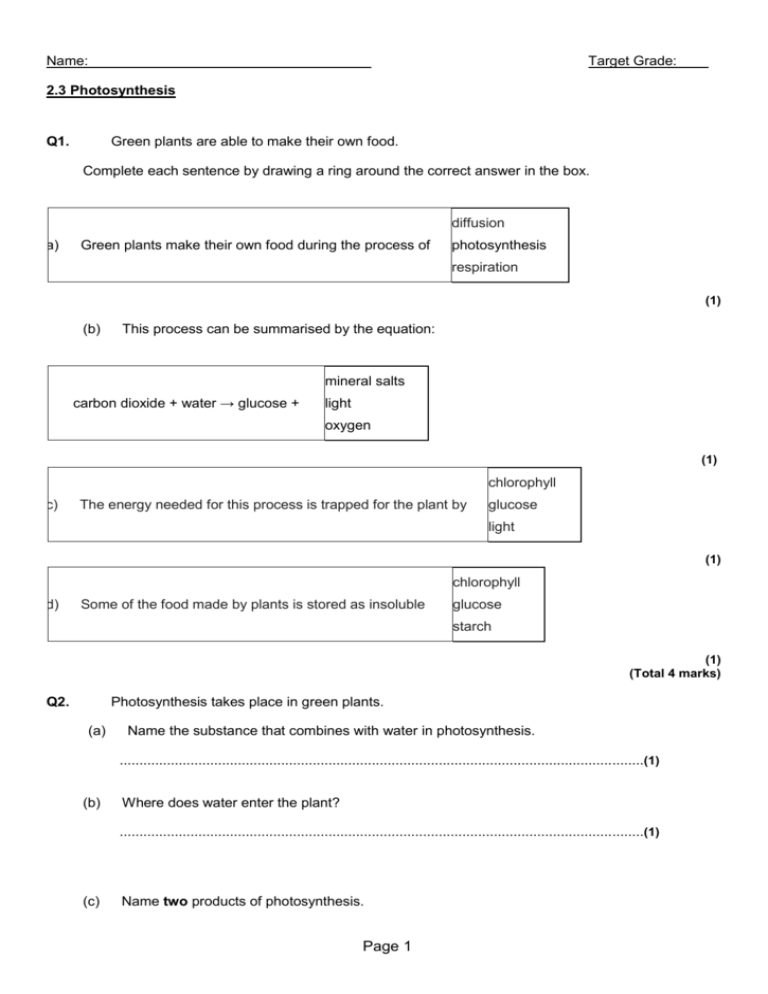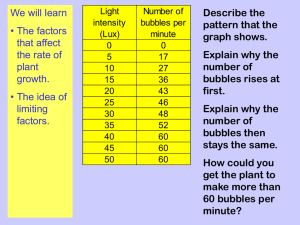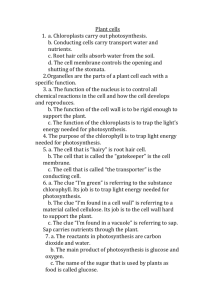2.3 Photosynthesis - Life Learning Cloud
advertisement

Name: Target Grade: 2.3 Photosynthesis Q1. Green plants are able to make their own food. Complete each sentence by drawing a ring around the correct answer in the box. diffusion (a) Green plants make their own food during the process of photosynthesis respiration (1) (b) This process can be summarised by the equation: mineral salts carbon dioxide + water → glucose + light oxygen (1) chlorophyll (c) The energy needed for this process is trapped for the plant by glucose light (1) chlorophyll (d) Some of the food made by plants is stored as insoluble glucose starch (1) (Total 4 marks) Q2. Photosynthesis takes place in green plants. (a) Name the substance that combines with water in photosynthesis. .....................................................................................................................................(1) (b) Where does water enter the plant? .....................................................................................................................................(1) (c) Name two products of photosynthesis. Page 1 .....................................................................................................................................(2) (d) Variegated leaves have areas that are green and areas that are white. Some students used variegated leaves to investigate photosynthesis. •They covered a variegated leaf with a black paper shape. •The leaf was left in a sunny place. •They tested the leaf for starch. •The results were compared with a leaf that was not covered. Start present after test Area of the leaf tested covered uncovered Green area no yes White area no no Explain why starch was present in only one of the tests. ..................................................................................................................................... ..................................................................................................................................... ..................................................................................................................................... ..................................................................................................................................... ..................................................................................................................................... ..................................................................................................................................... .....................................................................................................................................(4) (Total 8 marks) Page 2 Q3. A gardener grows tomatoes. He wants to find out how to get the biggest mass of tomatoes. tomato against different walls in his garden. He plants different varieties of Use these results to answer the questions. (a) The gardener wants his test to be fair. Name one condition which he should keep the same for all his tomato plants. ..................................................................................................................................... .....................................................................................................................................(1) (b) The table shows the gardener’s results. Variety of tomato plant Wall they were planted against Mean mass of tomatoes produced in kilograms per plant Sungold Sungold Sungold Sungold Nugget Champion North West South East East East 3.5 3.0 1.2 2.5 3.2 2.7 (i) To obtain the biggest mass of tomatoes, against which wall is it best to grow the tomato plants. Tick ( ) one box. North wall South wall East wall West wall (1) Page 3 (ii) To obtain the biggest mass of tomatoes, which variety of tomato plant would it be best to grow? ........................................................................................................................... (1) (c) From the information in the table, the gardener’s test was not fair. Give one way in which the test was not fair. ..................................................................................................................................... .....................................................................................................................................(1) (Total 4 marks) Q4. (a) The equation describes the process of photosynthesis. carbon dioxide + .................. + light energy glucose + .................. (i) Write in the names of the two missing substances. (ii) Name the green substance which absorbs the light energy. (2) ........................................................................................................................... (1) (b) (i) In bright sunlight, the concentration of carbon dioxide in the air can limit the rate of photosynthesis. Explain what this means. ........................................................................................................................... ........................................................................................................................... ........................................................................................................................... (2) (ii) Give one environmental factor, other than light intensity and carbon dioxide concentration, which can limit the rate of photosynthesis. ........................................................................................................................... (1) (Total 6 marks) Q5. The graph shows the effect of temperature on photosynthesis. Page 4 (a) Between which temperatures is the rate of photosynthesis fastest? ............................... and .......................... °C (b) (1) Suggest why the rate of photosynthesis stays the same between these two temperatures. ..................................................................................................................................... ..................................................................................................................................... .....................................................................................................................................(2) (c) A greenhouse owner wants to grow lettuces as quickly and cheaply as possible in winter. At what temperature should he keep his greenhouse in order to grow the lettuces as quickly and cheaply as possible? .......................... °C Explain your answer. ..................................................................................................................................... ..................................................................................................................................... .....................................................................................................................................(3) (Total 6 marks) The diagram shows some plants growing in a greenhouse on a hot summer’s day. Q6. Which one of the following factors is most likely to limit the rate of photosynthesis at this time? • carbon dioxide concentration Page 5 • light intensity • temperature Factor ............................................................................................ Explain the reason for your answer. ............................................................................................................................................... ............................................................................................................................................... ............................................................................................................................................... ............................................................................................................................................... ............................................................................................................................................... (Total 4 marks) M1. (a) photosynthesis 1 (b) oxygen 1 (c) chlorophyll 1 (d) starch 1 [4] M2. (a) carbon dioxide/CO2 1 (b) through the roots/root hairs do not accept leaves 1 (c) oxygen 1 sugar/glucose/other named sugar/starch/carbohydrate 1 (d) award one mark for each mark point Page 6 n.b. accept chloroplast for chlorophyll n.b. credit the candidate who answers in terms of the white areas of the leaf chlorophyll is green e.g. green areas have chlorophyll 1 chlorophyll/green is needed for photosynthesis e.g. it is only in green areas that photosynthesis can take place after this point do not penalise a candidate if they do not refer to photosynthesis 1 light is needed e.g. it does not happen in the dark do not accept sunshine/sun 1 photosynthesis produces/makes starch e.g. starch is made so e.g. ‘you need light to make starch’ scores 3rd and 4th marking points ‘you need chlorophyll and light for photosynthesis’ scores on the 2nd and 3rd marking points ‘photosynthesis makes starch and you need green leaves and light for it to work’ scores on the 2nd, 3rd and 4th marking points 1 [8] M3. (a) any one from: • (type of / amount of) soil / minerals / nutrients / pH • amount of water / time of watering • space between plants / plants and wall • time for growth Page 7 list principle ignore carbon dioxide / same number of plants / food do not allow temperature / light / exposure to wind 1 (b) (i) North wall 1 (ii) nugget list principle 1 (c) has not tested all varieties / nugget / champion against all walls do not allow repeat experiment 1 [4] M4. (a) (i) L.H.S. – water / H2O 1 R.H.S. – oxygen / O2 accept H2O accept O2 / O 1 (ii) chlorophyll must make it clear that it is the chlorophyll do not credit chloroplast on its own do not accept chloroplast / chlorophyll without indication that it is chlorophyll 1 (b) (i) light intensity / temperature is high enough for higher rate or light / temperature is not limiting 1 low CO2 available or not enough CO2 available or rate would be higher with more CO2 1 Page 8 (ii) temperature allow water / rain allow (too) cold / hot as a minimum allow wave length / frequency / colour ignore ions ignore heat 1 [6] M5. (a) 21.5 – 22 and 27 – 27.5 for 1 mark 1 (b) ideas of limiting factor / shortage of e.g. light / carbon dioxide / water / chlorophyll each for 1 mark (allow 1 for ‘maximum / optimum rate of enzyme activity if no reference to limiting factors) (ignore denaturation) 2 (c) 21.5 – 22° C (allow first figure from answer to (i) so that no ‘double-penalty but only if this first answer is 20 or greater) maximum rate of photosynthesis / highest / fastest but related to flat part of curve most economical heating / cheapest related to heating must relate to the temperature the candidate has given each for 1 mark 3 [6] M6. carbon dioxide concentration 1 Page 9 since atmospheric concentration very low / value give e.g. 0.03% allow carbon dioxide used up 1 temperature high allow if light chosen as a factor 1 light intensity high allow If temperature chosen as a factor 1 [4] Page 10








